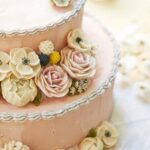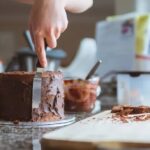Colorful and vibrant decorations can truly elevate the visual appeal of a cake, making it a feast for both the eyes and the taste buds. One popular way to add a pop of color to desserts is by using colored sugar, which can be easily customized to match any theme or occasion.
In this article, we will explore how to make colored sugar for cake decorating at home, providing you with a fun and budget-friendly way to enhance your baked creations.
Learning how to make colored sugar for cake decorating opens up a world of endless possibilities in terms of design and creativity. By customizing the colors of your sugar crystals, you can perfectly coordinate them with the color scheme of your cake or create stunning contrasts that stand out beautifully. Whether you’re aiming for a subtle pastel look or bold, vibrant shades, homemade colored sugar allows you to achieve the exact hue you desire.
Not only does colored sugar add visual appeal to your cakes, but it also provides a delightful textural element. The crunchy texture of the colored crystals adds depth and dimension to your decorations, making them not just visually appealing but also interestingly tactile. With just a few simple ingredients and tools, you can easily create your own batch of colorful sugar for cake decorating, adding a personalized touch to your sweet treats.
Materials Needed
| Ingredients | Tools |
|---|---|
| Granulated sugar | Bowls for mixing |
| Food coloring (gel or liquid) | Spoons or spatulas for mixing |
| Plastic zip-top bags or containers | Parchment paper or baking sheet |
Once you have gathered all the necessary ingredients and tools, you are ready to start making your colored sugar. The process is simple and can be customized to create any shade you desire. Whether you want pastel hues or bold colors, it’s easy to achieve with just a few drops of food coloring.
To make colored sugar, start by adding granulated sugar to a bowl. Depending on how much colored sugar you need, adjust the amount of sugar accordingly. Then, add a few drops of food coloring to the sugar and mix well until the color is evenly distributed. You can also use multiple colors to create custom blends for a unique touch to your cake decorations.
After mixing the sugar and food coloring thoroughly, spread it out on parchment paper or a baking sheet to dry. Allow the colored sugar to air dry completely before storing it in plastic zip-top bags or containers for future use. With this simple method, you can have an array of vibrant colored sugars ready to elevate your cake decorating projects anytime.
Step-by-Step Instructions
Creating your own colored sugar at home is a fun and easy way to add a personalized touch to your cake decorating. With just a few simple ingredients and some patience, you can have vibrant colored sugar to use in various ways. Here’s a detailed guide on how to make colored sugar for cake decorating.
Gather Your Materials
To make colored sugar, you will need granulated sugar, gel food coloring (liquid food coloring can work as well but may require more drying time), airtight containers or ziplock bags, and parchment paper. It’s important to use gel food coloring as it provides more intense colors without adding extra moisture to the sugar.
Mixing the Sugar and Color
Start by placing about 1 cup of granulated sugar into a mixing bowl. Add a small amount of gel food coloring – start with just a drop or two for pastel shades and increase as needed for darker colors. Mix the sugar and color together using a fork or your hands until the color is evenly distributed. If the color isn’t deep enough, add more coloring gradually until you achieve your desired shade.
Drying and Storing
Spread out the colored sugar onto parchment paper in a thin layer to dry completely. This process can take anywhere from a few hours to overnight, depending on the humidity level in your area. Once dry, store the colored sugar in an airtight container or ziplock bag until ready to use on your cakes or other baked goods.
Stored properly, homemade colored sugar can last for months. Now you have your own custom-colored sugar ready for all your cake decorating needs.
Choosing Colors
When it comes to making colored sugar for cake decorating, selecting the right food coloring is key to achieving vibrant and appealing colors. The type of food coloring you choose can significantly impact the final result, so it’s essential to pay attention to this aspect.
Gel food coloring is often recommended for coloring sugar as it provides more intense and vivid hues compared to liquid food coloring. Additionally, gel food coloring is thicker in texture, which helps prevent the sugar from becoming too wet or sticky during the coloring process.
When choosing colors for your colored sugar, consider the final look you want to achieve on your cakes or baked goods. For bold and bright colors, opt for gel food coloring in primary shades such as red, blue, yellow, and green.
These colors can be easily mixed together to create a wide range of secondary colors like orange, purple, and teal. If you prefer pastel shades for a softer touch in your cake decorations, dilute the gel food coloring with a small amount of water before adding it to the sugar.
It’s also important to keep in mind that certain food coloring brands may produce different results in terms of color intensity and consistency. Some experimentation may be needed to find the right balance between achieving vibrant colors and maintaining the right texture of the colored sugar.
Remember that a little goes a long way when working with gel food coloring, so start by adding small amounts until you reach the desired color saturation. By carefully selecting and mixing your food coloring, you can create beautifully colored sugar that will elevate your cake decorating projects.
| Choosing Colors Tips | Selecting Food Coloring |
|---|---|
| Consider final look desired | Gel food coloring recommended |
| Experiment with different brands | Start with small amounts |
Storing Colored Sugar
When it comes to cake decorating, colored sugar is a versatile and essential ingredient that adds a pop of color and texture to any sweet treat. Whether you’re baking a birthday cake or decorating cupcakes for a special occasion, having a stash of colored sugar on hand can elevate your creations to the next level.
In this section, we will delve into the best practices for storing and preserving colored sugar for future use, ensuring that you always have a vibrant supply ready for your baking adventures.
Proper Storage Containers
One of the key factors in maintaining the freshness and vibrancy of colored sugar is using the right storage containers. It is recommended to store colored sugar in airtight containers that are both moisture-proof and light-resistant. Mason jars or plastic containers with tight-fitting lids work well for this purpose. Make sure to label your containers with the colors of the sugar inside to easily identify them when you need them for decorating.
Controlling Moisture
Moisture is one of the main enemies of colored sugar, as it can cause clumping and discoloration over time. To prevent this, consider adding a small silica gel packet or a dash of cornstarch to absorb any excess moisture in the container. Additionally, storing your colored sugar in a cool, dry place away from direct sunlight will help maintain its quality for longer periods.
Long-Term Preservation
If you anticipate not using all of your homemade colored sugar within a short period, freezing it can be an effective method for long-term preservation. Simply divide the colored sugar into smaller portions and store them in freezer-safe bags or containers.
When you’re ready to use the colored sugar, allow it to come to room temperature before sprinkling it on your baked goods. By following these best practices for storing and preserving colored sugar, you can ensure that your supplies are always ready whenever inspiration strikes for your next cake decorating project.
Creative Uses
When it comes to cake decorating, colored sugar can add a pop of color and texture to your creations. While sprinkling colored sugar on top of baked goods is a classic way to use it, there are many creative ways to incorporate this colorful ingredient into your designs. Here are some innovative ideas for using colored sugar in cake decorating:
- Layered Ombre Effect: Create an ombre effect on the sides of your cake by layering different shades of colored sugar from lightest to darkest. Simply press the colored sugar onto the frosting in horizontal layers, starting with the lightest color at the top and gradually getting darker towards the bottom.
- Sugar Shaped Designs: Use shaped molds or cookie cutters to create intricate designs with colored sugar. Fill the molds with different colors of sugar and press firmly before carefully removing them to reveal beautifully shaped sugar decorations. You can then attach these sugar shapes to your cakes using frosting or edible glue.
- Edible Borders and Patterns: Instead of traditional piping or fondant decorations, try using colored sugar to create borders and patterns on your cakes. Use a piping bag filled with colored sugar to pipe decorative borders around the edges of your cakes or sprinkle colored sugar in stencils to create intricate patterns.
Incorporating colored sugar in these unique ways can elevate your cake decorating skills and add a touch of whimsy to your baked creations. Experiment with different colors, shapes, and techniques to discover new ways to use this versatile ingredient in your designs.
- Cake Toppers: Create custom cake toppers using colored sugar by shaping it into letters, numbers, or even small figurines. These edible accents can add a personalized touch to birthday cakes, wedding cakes, or any special occasion treats.
- Faux Sprinkles: Make homemade sprinkles using colored sugar by mixing it with a little bit of water or corn syrup and pressing it through a sieve for tiny colorful pellets. These DIY sprinkles can be used as garnishes on cupcakes, cookies, or even ice cream sundaes.
- Mix-in Fillings: Add a pop of color and sweetness by incorporating colored sugar into filling layers for multi-layered cakes or pastries. Mix colored sugar into buttercream frosting, whipped cream, or fruit preserves for vibrant fillings that will surprise and delight your taste buds.
From creating intricate designs and textures to adding surprising embellishments and flavors, there are endless possibilities when it comes to incorporating homemade colored sugar into your cake decorating repertoire. Get creative with your designs and have fun experimenting with different ways to make your sweet treats stand out.
Troubleshooting
While making colored sugar for cake decorating, it is common to encounter some issues along the way. Understanding how to troubleshoot these problems can make the process smoother and more successful. Here are some common issues that may arise and ways to fix them:
1. Clumping: One of the most common issues when making colored sugar is clumping. This can happen if the food coloring is added too quickly or if there is excess moisture in the sugar. To prevent clumping, make sure to add the food coloring gradually, mixing well after each addition. If clumps still form, try spreading the colored sugar out on a baking sheet and allowing it to dry completely before breaking up any clumps.
2. Uneven Coloring: Sometimes, the colored sugar may not have a consistent hue throughout due to uneven mixing or distribution of food coloring. To avoid this problem, be sure to mix the food coloring thoroughly into the sugar, ensuring even coverage. If you notice patches of lighter or darker color, simply remix the sugar until it reaches a uniform shade.
3. Sticky Texture: If your colored sugar ends up with a sticky texture after adding food coloring, it could be due to excessive moisture in the environment or not enough drying time. Spread out the colored sugar on a baking sheet and let it air dry for a longer period before storing or using it for cake decorating purposes.
By being aware of these common issues and knowing how to address them, you can achieve perfect homemade colored sugar for all your cake decorating needs. Don’t let these challenges discourage you – with a little patience and practice, you’ll soon become an expert at creating vibrant and beautiful edible decorations for your baked treats.
- Clumping
- Uneven Coloring
- Sticky Texture
Conclusion
In conclusion, learning how to make colored sugar for cake decorating opens up a world of possibilities for adding a personalized touch to your baked creations. By following the simple steps outlined in this guide and experimenting with different colors and techniques, you can elevate the visual appeal of your cakes and desserts. Homemade colored sugar allows you to customize the shade, texture, and even flavor of your decorations, making each treat unique and special.
Furthermore, by mastering the art of creating colored sugar at home, you not only save money but also have full control over the ingredients used. This means you can avoid artificial additives or unwanted chemicals often found in store-bought versions. Storing your homemade colored sugar properly ensures that you always have a vibrant supply on hand for future confectionery projects.
Whether you choose to sprinkle it on top of frosted treats, use it to create intricate designs, or add a touch of sparkle to your desserts, colored sugar adds an extra layer of charm and whimsy to any cake decorating endeavor. With a little creativity and practice, you can turn simple sweets into stunning works of edible art that delight both the eyes and taste buds.
So why not unleash your imagination and start exploring all the ways homemade colored sugar can enhance your baking adventures today?
Frequently Asked Questions
Can You Make Colored Sugar at Home?
Making colored sugar at home is a simple process that involves adding food coloring to granulated sugar and mixing it until the color is evenly distributed. You can use liquid or gel food coloring, depending on your preference and the intensity of color you desire.
Just be sure to let the sugar dry completely before using it in your recipes or decorating.
How Do You Make Colored Icing Sugar?
To make colored icing sugar, you can follow a similar process to making colored granulated sugar. Start by adding food coloring to powdered sugar and mixing it well until the color is uniform throughout.
You may need to adjust the amount of food coloring based on the shade you want to achieve. Colored icing sugar can add a fun and vibrant touch to your baked goods or desserts.
How Do You Color Sugar Without Food Coloring?
If you prefer not to use food coloring to color sugar, there are natural alternatives you can try. One method is using fruit or vegetable juices such as beet juice, carrot juice, or blueberry juice to tint the sugar naturally.
Another option is using natural powders like matcha powder, turmeric, or cocoa powder for different colors without artificial additives. Experiment with these options to create beautiful colored sugars without food coloring.

Welcome to my blog about home and family. This blog is a place where I will share my thoughts, ideas, and experiences related to these important topics. I am a stay-at-home mom with two young children. I hope you enjoy reading it! and may find some helpful tips and ideas that will make your home and family life even better!





